The genome of the obligate intracellular parasite Trachipleistophora hominis: new insights into microsporidian genome dynamics and reductive evolution
- PMID: 23133373
- PMCID: PMC3486916
- DOI: 10.1371/journal.ppat.1002979
The genome of the obligate intracellular parasite Trachipleistophora hominis: new insights into microsporidian genome dynamics and reductive evolution
Abstract
The dynamics of reductive genome evolution for eukaryotes living inside other eukaryotic cells are poorly understood compared to well-studied model systems involving obligate intracellular bacteria. Here we present 8.5 Mb of sequence from the genome of the microsporidian Trachipleistophora hominis, isolated from an HIV/AIDS patient, which is an outgroup to the smaller compacted-genome species that primarily inform ideas of evolutionary mode for these enormously successful obligate intracellular parasites. Our data provide detailed information on the gene content, genome architecture and intergenic regions of a larger microsporidian genome, while comparative analyses allowed us to infer genomic features and metabolism of the common ancestor of the species investigated. Gene length reduction and massive loss of metabolic capacity in the common ancestor was accompanied by the evolution of novel microsporidian-specific protein families, whose conservation among microsporidians, against a background of reductive evolution, suggests they may have important functions in their parasitic lifestyle. The ancestor had already lost many metabolic pathways but retained glycolysis and the pentose phosphate pathway to provide cytosolic ATP and reduced coenzymes, and it had a minimal mitochondrion (mitosome) making Fe-S clusters but not ATP. It possessed bacterial-like nucleotide transport proteins as a key innovation for stealing host-generated ATP, the machinery for RNAi, key elements of the early secretory pathway, canonical eukaryotic as well as microsporidian-specific regulatory elements, a diversity of repetitive and transposable elements, and relatively low average gene density. Microsporidian genome evolution thus appears to have proceeded in at least two major steps: an ancestral remodelling of the proteome upon transition to intracellular parasitism that involved reduction but also selective expansion, followed by a secondary compaction of genome architecture in some, but not all, lineages.
Conflict of interest statement
The authors have declared that no competing interests exist.
Figures
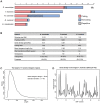
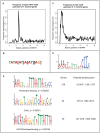
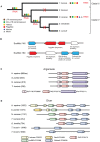



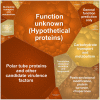
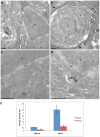
Similar articles
-
Reduction and expansion in microsporidian genome evolution: new insights from comparative genomics.Genome Biol Evol. 2013;5(12):2285-303. doi: 10.1093/gbe/evt184. Genome Biol Evol. 2013. PMID: 24259309 Free PMC article.
-
Plasma membrane-located purine nucleotide transport proteins are key components for host exploitation by microsporidian intracellular parasites.PLoS Pathog. 2014 Dec 4;10(12):e1004547. doi: 10.1371/journal.ppat.1004547. eCollection 2014 Dec. PLoS Pathog. 2014. PMID: 25474405 Free PMC article.
-
Transcriptomic profiling of host-parasite interactions in the microsporidian Trachipleistophora hominis.BMC Genomics. 2015 Nov 21;16:983. doi: 10.1186/s12864-015-1989-z. BMC Genomics. 2015. PMID: 26589282 Free PMC article.
-
The intriguing nature of microsporidian genomes.Brief Funct Genomics. 2011 May;10(3):115-24. doi: 10.1093/bfgp/elq032. Epub 2010 Dec 21. Brief Funct Genomics. 2011. PMID: 21177329 Review.
-
Energy metabolism and its evolution in Microsporidia and allied taxa.Parasitol Res. 2020 May;119(5):1433-1441. doi: 10.1007/s00436-020-06657-9. Epub 2020 Mar 21. Parasitol Res. 2020. PMID: 32200463 Review.
Cited by
-
Horizontally acquired genes in early-diverging pathogenic fungi enable the use of host nucleosides and nucleotides.Proc Natl Acad Sci U S A. 2016 Apr 12;113(15):4116-21. doi: 10.1073/pnas.1517242113. Epub 2016 Mar 29. Proc Natl Acad Sci U S A. 2016. PMID: 27035945 Free PMC article.
-
Methanosaeta and "Candidatus Velamenicoccus archaeovorus".Appl Environ Microbiol. 2022 Apr 12;88(7):e0240721. doi: 10.1128/aem.02407-21. Epub 2022 Mar 21. Appl Environ Microbiol. 2022. PMID: 35311510 Free PMC article.
-
Effects of the vertically transmitted microsporidian Facilispora margolisi and the parasiticide emamectin benzoate on salmon lice (Lepeophtheirus salmonis).BMC Genomics. 2017 Aug 17;18(1):630. doi: 10.1186/s12864-017-4040-8. BMC Genomics. 2017. PMID: 28818044 Free PMC article.
-
Biogenesis, inheritance, and 3D ultrastructure of the microsporidian mitosome.Life Sci Alliance. 2023 Oct 30;7(1):e202201635. doi: 10.26508/lsa.202201635. Print 2024 Jan. Life Sci Alliance. 2023. PMID: 37903625 Free PMC article.
-
Reduction and expansion in microsporidian genome evolution: new insights from comparative genomics.Genome Biol Evol. 2013;5(12):2285-303. doi: 10.1093/gbe/evt184. Genome Biol Evol. 2013. PMID: 24259309 Free PMC article.
References
-
- Williams BA, Keeling PJ (2011) Microsporidia - highly reduced and derived relatives of Fungi. In: Poeggeler S, Woestemeyer J, editors. Evolution of Fungi and Fungal-like Organisms. Heidleberg: Springer. pp. 25–36.
-
- Wittner MW, Weiss L.M. (1999) The Microsporidia and Microsporidiosis. Washington D. C.: ASM Press. 553 p.
-
- Embley TM, Martin W (2006) Eukaryotic evolution, changes and challenges. Nature 440: 623–630. - PubMed
Publication types
MeSH terms
Substances
Grants and funding
LinkOut - more resources
Full Text Sources
Other Literature Sources
Molecular Biology Databases
Miscellaneous

